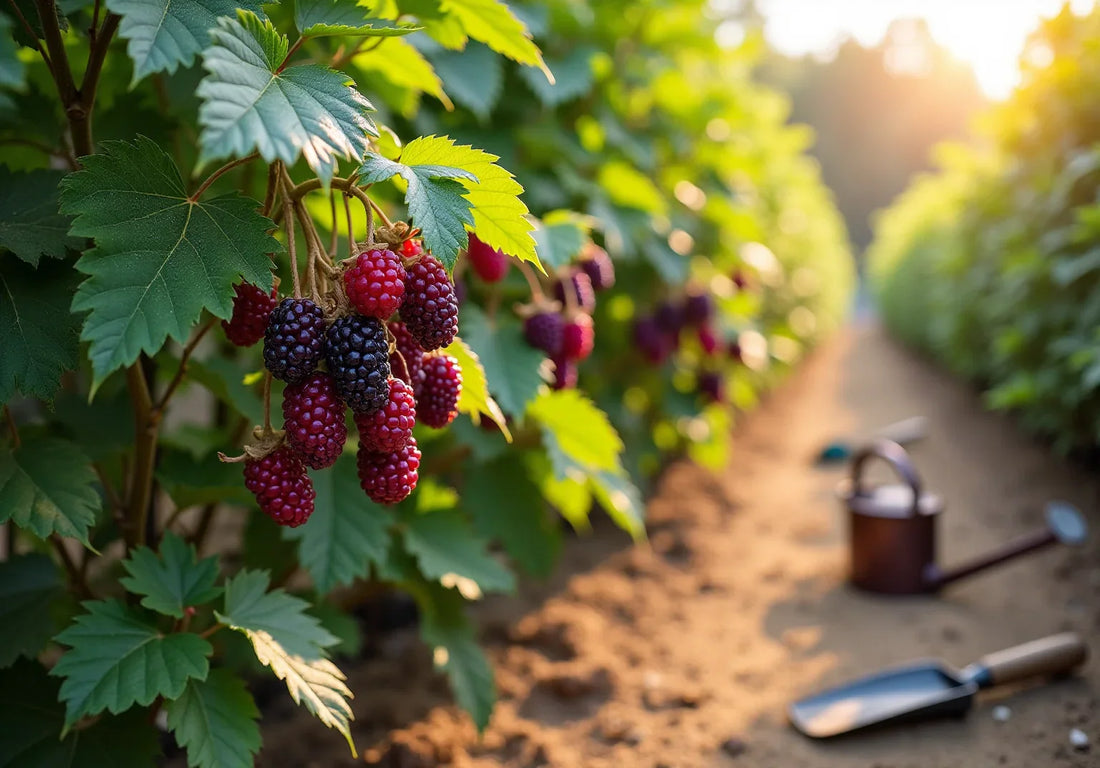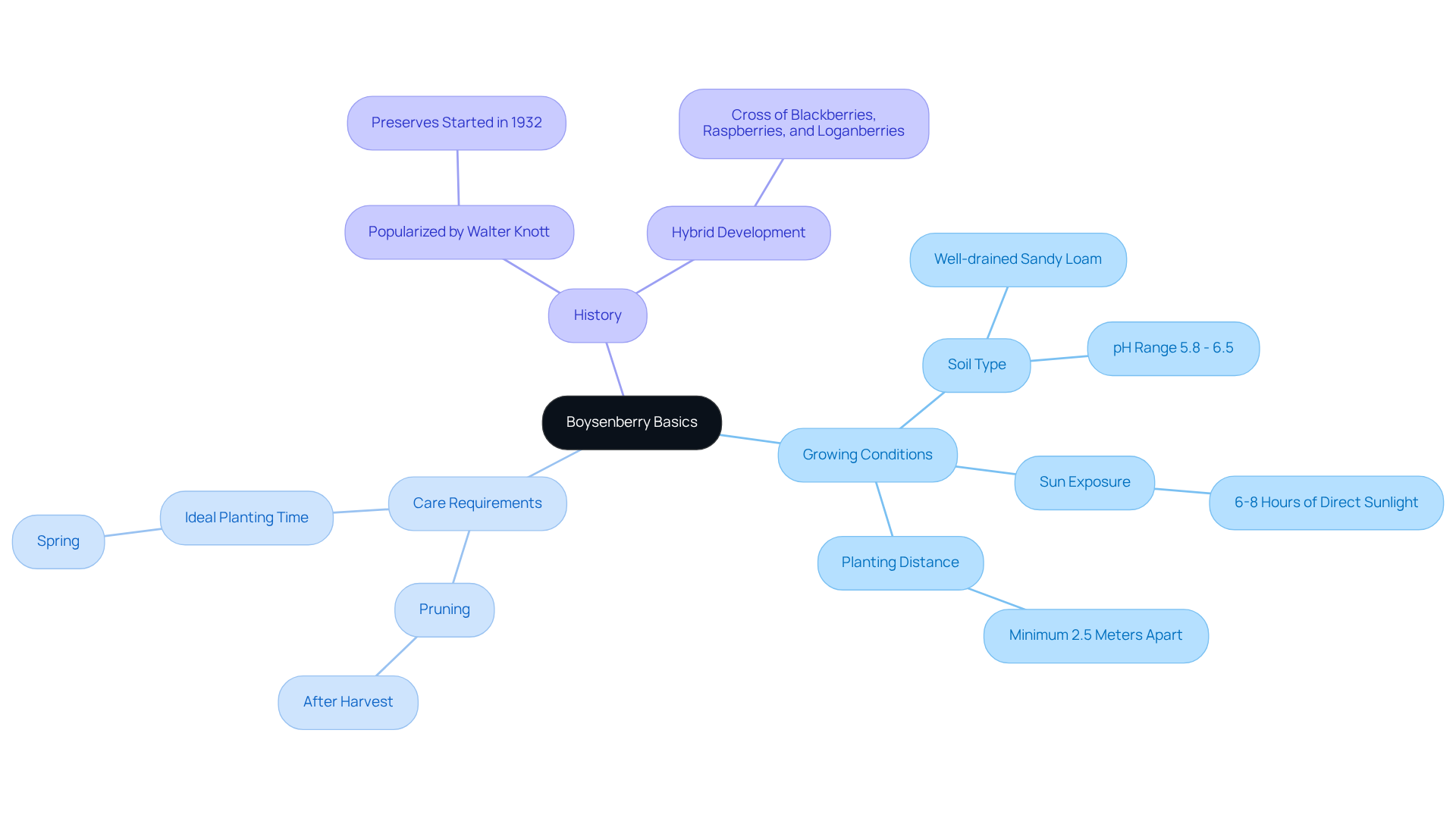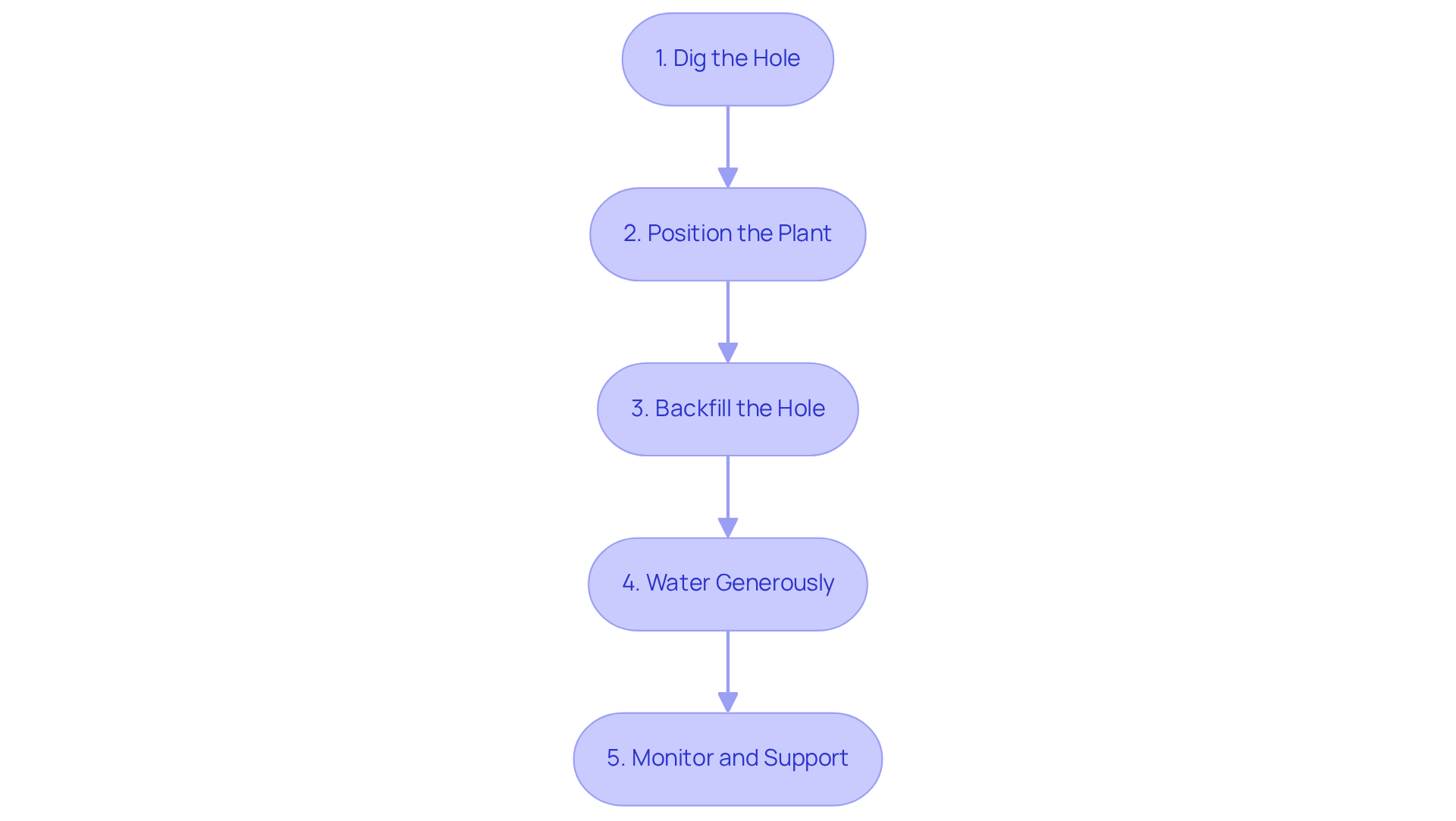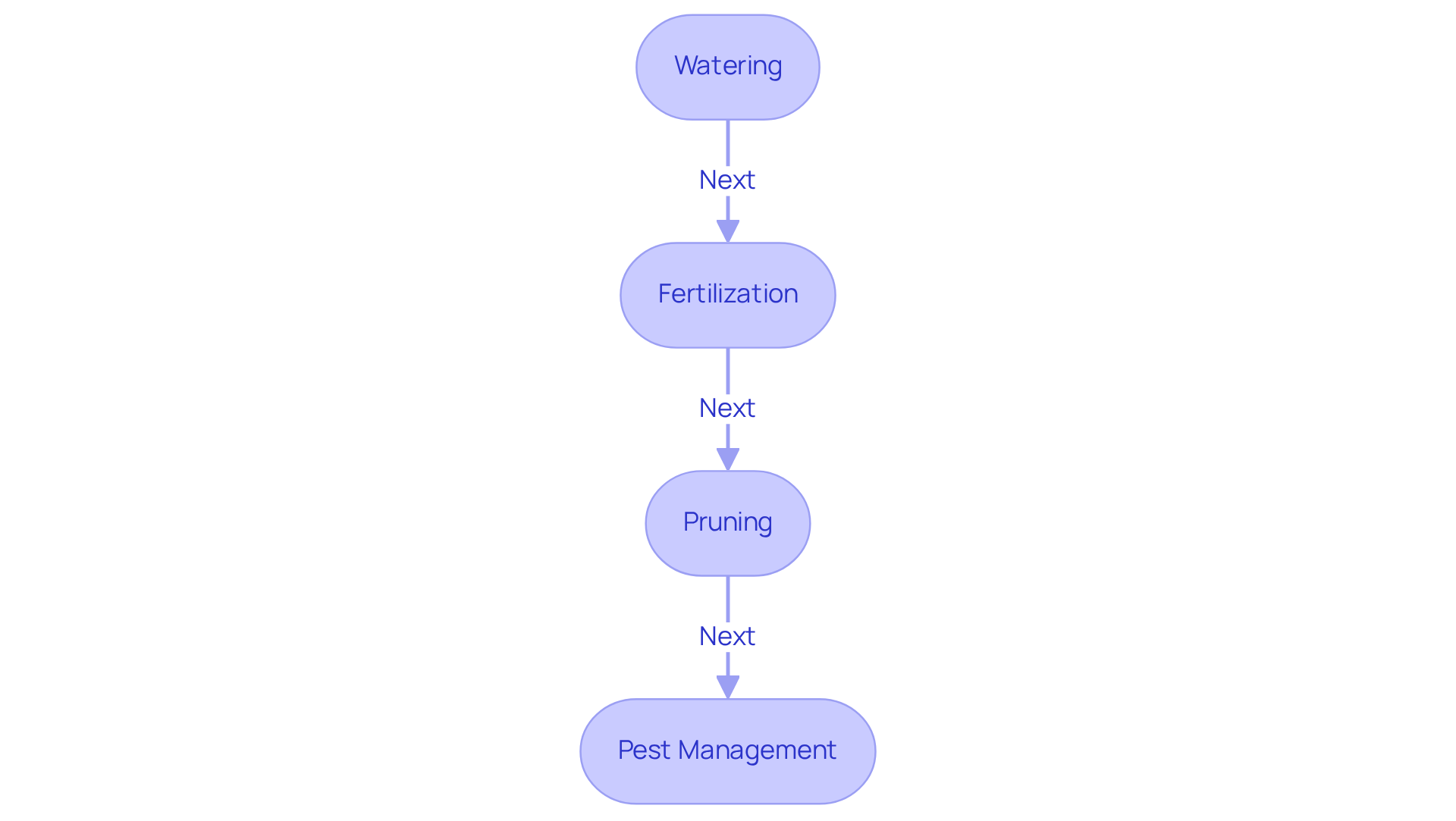
Boysenberry Plant for Sale: Where to Buy & Care Tips
Share
Cultivating boysenberries presents a unique opportunity for both novice and experienced gardeners to explore the rich flavors of this hybrid fruit, celebrated for its sweet-tart taste and versatility. By mastering the essential steps of planting and caring for these delectable trees, growers can unlock the potential for abundant yields, transforming a simple gardening endeavor into a profitable venture. However, the journey to successfully grow boysenberries is not without its challenges. What are the key practices that ensure these plants thrive and produce fruit worth selling?
Where can you buy a Boysenberry Plant for sale?
Check out the Boysenberry Bush Plant at Everglades Farm - shipped directly from Florida.
Understand Boysenberry Basics
Boysenberries are a delightful hybrid fruit, resulting from the crossbreeding of blackberries, raspberries, and loganberries. They thrive in USDA hardiness zones 5-10 and prefer well-drained, sandy loam soil with a pH range of 5.8 to 6.5. These specimens require complete sun exposure, ideally soaking in 6-8 hours of direct sunlight daily. For optimal development, young seedlings should be planted at a minimum distance of 2.5 meters apart. Cultivating boysenberries in spring is ideal, enabling them to thrive robustly during the summer months.
By understanding these fundamental requirements, you can create an ideal environment for your berry plants, promoting vigorous growth and maximizing fruit yield, which averages between 1.5 to 2 kg per plant. Additionally, pruning should be performed right after harvesting the berries to ensure healthy production in the following season. This knowledge not only aids in cultivation but also connects you to the rich history of this fruit, popularized by Walter Knott in the 1930s.

Prepare Your Planting Site and Tools
-
Choose a Location: Select a site that receives full sun for at least 6-8 hours daily and has good air circulation. Avoid locations with dense shade or stagnant water, as these conditions can impede development and fruit production.
-
Test the Soil: Conduct a soil test to assess pH and nutrient levels, aiming for a pH between 5.8 and 6.5 for optimal development of boysenberries. Soil testing is essential, as it guides necessary adjustments to improve fertility and drainage, ensuring a healthy environment for your plants.
-
Gather Tools: Equip yourself with essential gardening tools, including a shovel, rake, trowel, and a watering can or hose. If you plan to plant multiple trees, consider setting up a trellis system for support, which will help manage growth and improve air circulation. Ensure that any pots used for container planting have drainage holes to prevent waterlogging.
-
Prepare the Ground: Loosen the soil to a depth of at least 12 inches, mixing in compost or organic matter to enhance structure and nutrient content. This preparation is crucial, as these berries thrive in rich, moisture-retaining soil. Appropriate substrate enhancement can significantly affect plant vitality and fruit production, with research indicating that well-prepared soil can sustain boysenberry plant for sale for as long as 15 years without requiring substantial modifications.
-
Amend the Soil: Based on your soil test results, amend the soil as needed. Incorporate lime to raise pH or sulfur to lower it, ensuring the ideal range for the fruit. Regular amendments can lead to healthier plants and a more abundant harvest, making this step essential for successful cultivation.

Plant Your Boysenberry Plant
-
Dig the hole for the boysenberry plant for sale: Prepare a hole that is twice as wide and deep as the root ball of the boysenberry plant for sale. This ensures ample space for the roots to expand and establish themselves effectively, promoting strong growth.
-
Position the Plant: Center the plant in the hole, making sure that the crown is level with the ground surface. Proper positioning is crucial for the plant's health and growth, as it allows for optimal nutrient uptake and stability.
-
Backfill the Hole: Refill the hole with the original earth blended with compost, gently tamping it down to remove air pockets. This nutrient-rich mixture enhances ground structure and provides vital resources for the plant's development.
-
Water Generously: After planting, water the tree thoroughly to help settle the ground around the roots. Boysenberries require approximately 1 inch of water every 10 days, particularly during dry periods. Maintaining consistent moisture in the soil is essential; ensure it remains moist but not waterlogged.
-
Monitor and Support: As the berry plant grows, provide support with a trellis or wire system to help the vines thrive. Regularly check moisture levels and prune as necessary to promote healthy growth and fruit production. Successful planting examples demonstrate that with proper care, you can find a boysenberry tree for sale that yields abundant harvests from June through August.

Maintain and Care for Your Boysenberry Plant
-
Watering: It is essential to keep the ground consistently moist, especially during dry spells. Aim for approximately 1-2 inches of water weekly, adjusting based on rainfall. Boysenberries are not drought-tolerant; they thrive best with regular moisture. Therefore, consider watering deeply to encourage strong root development. For optimal results, water approximately 0.5 cups every 9 days to sustain moisture in the ground.
-
Fertilization: Begin with a balanced fertilizer in early spring, followed by another application in mid-summer to promote vigorous development. Organic fertilizers, such as compost or fish emulsion, are excellent choices, as they enhance healthy soil and vegetation vitality. After the initial spring application, fertilize every four weeks with a 20-20-20 mix for the best results.
-
Pruning: Pruning should be conducted in late winter to remove any dead or damaged canes, which encourages new growth and improves air circulation. This practice not only enhances the health of the plants but also contributes to a more abundant harvest. Pruning is typically performed between autumn and winter, aligning with the best methods for caring for the bushes.
-
Pest Management: Regularly inspect your boysenberry bushes for common pests such as aphids and spider mites. Utilize organic pest control methods, such as insecticidal soap, to effectively manage any infestations while maintaining a sustainable gardening approach. Keeping your plants healthy and free from pests is crucial for achieving a successful yield.

Troubleshoot Common Growing Issues
-
Yellowing Leaves: This symptom often signals overwatering or a nutrient deficiency. To address this, check the ground moisture about 5cm below the surface. If the soil is consistently wet, it is advisable to reduce the watering frequency. Additionally, yellowing leaves can be part of the normal aging process, particularly for the oldest leaves near the bottom of the vegetation. In cases of nutrient deficiencies, especially iron, consider using a slow-release balanced fertilizer at the suggested rate to restore the health of the vegetation.
-
Wilting: Wilting can indicate underwatering, particularly during hot weather. It is essential to ensure that the ground remains consistently damp but not saturated. When considering a boysenberry plant for sale, it should be irrigated when the soil is dry approximately 5cm beneath the surface. Regularly checking the moisture level and adjusting your watering schedule will help maintain optimal hydration.
-
Pest infestations: Keep a vigilant eye on your boysenberry plant for sale crops for signs of pests, such as webbing or discolored leaves. Common pests include red berry mites and aphids. Utilizing organic pesticides or manually eliminating pests can help keep your greenery healthy. Additionally, implementing good garden hygiene, such as cleaning up debris, can prevent infestations and reduce the risk of harboring fungal spores.
-
Diseases: The boysenberry plant for sale is susceptible to diseases like powdery mildew and root rot. To prevent these issues, ensure adequate air circulation by spacing greenery appropriately and pruning crowded canes. Avoid overhead watering, which can create wet foliage and promote fungal growth. Regular inspections of your plants for early signs of disease will enable you to take prompt action.
Conclusion
Successfully cultivating boysenberry plants for sale is a rewarding endeavor that requires understanding their specific needs and care. By following the outlined steps—from selecting the right planting site to maintaining optimal growth conditions—one can ensure a bountiful harvest of these delicious berries. Creating an ideal environment for boysenberries not only maximizes yield but also connects growers to the rich heritage of this unique hybrid fruit.
This guide covers essential aspects such as:
- Soil preparation
- Proper planting techniques
- Ongoing maintenance, including watering, fertilization, and pest management
Each step is crucial in fostering healthy plants that produce fruit abundantly during the growing season. Recognizing signs of common issues like yellowing leaves or wilting can also help in troubleshooting and maintaining plant health.
In conclusion, growing boysenberry plants is not just about the practical steps involved; it presents an opportunity to engage with nature and enjoy the fruits of one's labor. With proper care and attention, these vibrant trees can thrive for years, providing delicious berries and a fulfilling gardening experience. Embrace the journey of cultivating boysenberries, and let the joy of gardening enrich your life while contributing to sustainable practices in fruit production.
Cultivate Your Own Boysenberry Paradise Today!
Start your gardening journey with Everglades Farm and enjoy delicious, home-grown fruits in no time.
🛒 Buy Boysenberry Bush Plant
🛒 Explore Grape and Berries Collection
Frequently Asked Questions
What are boysenberries and how are they cultivated?
Boysenberries are a hybrid fruit created from the crossbreeding of blackberries, raspberries, and loganberries. They thrive in USDA hardiness zones 5-10, prefer well-drained sandy loam soil with a pH of 5.8 to 6.5, and require 6-8 hours of direct sunlight daily. Young seedlings should be planted at least 2.5 meters apart, ideally in spring for robust summer growth.
What is the average fruit yield for boysenberry plants?
The average fruit yield for boysenberry plants is between 1.5 to 2 kg per plant.
When should boysenberries be pruned?
Pruning should be done right after harvesting the berries to promote healthy production in the following season.
How should I prepare the planting site for boysenberries?
Choose a location that receives full sun for at least 6-8 hours daily and has good air circulation. Avoid areas with dense shade or stagnant water, as these conditions can hinder development.
Why is soil testing important for growing boysenberries?
Soil testing is essential to assess pH and nutrient levels, ensuring the soil is within the ideal pH range of 5.8 to 6.5. This helps guide necessary adjustments to improve fertility and drainage, creating a healthy environment for the plants.
What tools are needed for planting boysenberries?
Essential tools include a shovel, rake, trowel, and a watering can or hose. If planting multiple trees, a trellis system can help manage growth and improve air circulation. Ensure any pots used have drainage holes to prevent waterlogging.
How should I prepare the ground for planting boysenberries?
Loosen the soil to a depth of at least 12 inches and mix in compost or organic matter to enhance the soil's structure and nutrient content. This preparation is crucial for the health and productivity of the plants.
How can I amend the soil for boysenberries?
Based on soil test results, amend the soil as needed by incorporating lime to raise pH or sulfur to lower it, ensuring it stays within the ideal range for boysenberries. Regular amendments can lead to healthier plants and a more abundant harvest.


